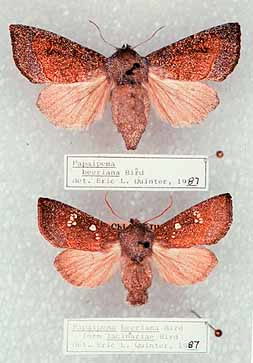
(Papaipema beeriana)
Interesting facts:
The time of day that moths are active can be affected by the temperature, humidity, precipitation, wind, and the phases of the moon.
Description:
This moth has a wingspan that measures from 31 to 36 mm (to 1 1/2 inches). There are two forms; one with white spots on the forewing, and one without. The unspotted form has dull brown front wings, a grayish body, and pale gray hind wings.
Habitat and behavior:
The blazing star borer moth, as its name suggests, is dependent upon the blazing star plant (Liatris spicata, Liatris pychnostachya, and Liatris aspera) to survive. The blazing star is a prairie plant that grows in mesic soil.
The female moth lays eggs in the fall in the soil near the Liatris plants. The larvae hatch in spring, make their way to the stem base of the Liatris, and bore into it to feed. In late summer, the larvae burrow into the soil to pupate (undergo metamorphosis to the pupal stage). They remain there for about a month. The adults emerge from late August or early September to October. These moths are usually active very late in the evengins.
Food:
The larva feeds in the inner stem and root base of the blazing star (Liatris sp) by boring a hole at the base of the stem.
Predators:
Natural enemies of Papaipema beeriana include rodents, skunks, woodpeckers, and parasitic flies and wasps.
Distribution and status:
Papaipema beeriana is found on prairies in the Chicago area and on prairie remnants in other parts of Illinois. It is listed as of special concern or endangered in several midwestern states. It has decreased in number because of loss of habitat.